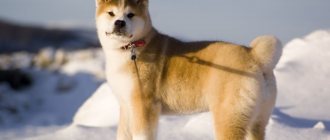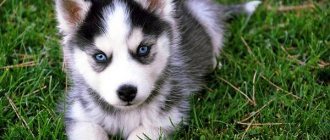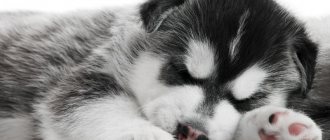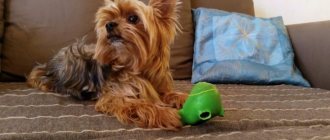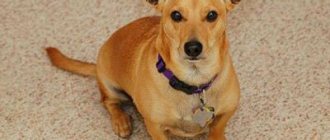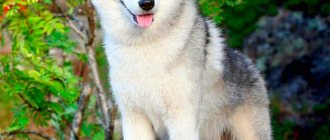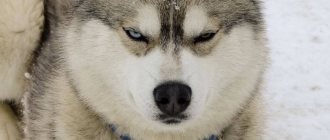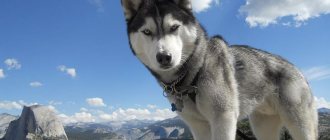The time has long passed when people desperately needed the help of strong and smart sled dogs. But the love for them did not disappear. Mini Huskies Klee Kai resemble those dogs in appearance and abilities, but only in a smaller size. This allows lovers of large huskies to keep a mini copy of them in their small apartment or house.
Mini Huskies Klee Kai resemble those dogs in appearance and abilities, but only in a smaller size
This breed began to be bred in the 70s of the last century in America (privately). To breed it, Siberian huskies were crossed with huskies and American Eskimo dogs (to reduce size, but not dwarfism). The goal was achieved after 18 years of hard work.
Initially, the breed was named “Klee Kai”, which translates as a small dog (from Eskimo), but the events of history influenced such that this breed received another name - the Alaskan Klee Kai.
History of the Alaskan Klee Kai breed
Alaskan Klee Kai
Compared to other natives of the North, Alaskan Klee Kais can be considered quite young. The history of the breed dates back to the 70s of the last century and is associated with a resident of Alaska, Linda Sparling. One day, she and her husband decided to visit relatives living in Oklahoma. The couple was greeted by a real miracle - a charming and unusually miniature husky, which followed the guests on their heels and showed lively interest. The animal's name was quite consistent with its character: Curious translated from English means “curious, unusual, wonderful.” Despite the fact that the dog was smaller than its relatives, all the signs of a husky were visible in its appearance - color and exterior.
Even then, Linda came up with the idea of creating a new miniature breed, and the woman persuaded her relatives to give her the dog. In her hometown, walks with Queries constantly attracted the attention of passers-by. They often stopped, wanting to take a closer look at the animal, and wondered if it was a puppy. The reason for the lively curiosity was simple: at that time there was a peak of interest in sled dogs. Many Americans wanted to acquire these amazing pets, but not everyone could keep a large dog in their apartments, which also required long active walks and had a rather difficult character.
Linda Sparling developed a strict breeding program, painstakingly selecting individuals for mating. Huskies, Eskimo dogs, Alaskan Malamutes and huskies were used. It took nearly twenty years of persistent breeding to eventually produce a dog that looked like a miniature husky. All this time, Linda did not inform anyone about the direction of her work. The first person who was able not only to get acquainted with the new breed, but also to obtain permission to photograph, was the mother of one of Linda’s comrades, journalist Eileen Gregory. It was she who insisted that it was time to “bring the dogs out into the world.”
Alaskan Klee Kai puppy
The public appearance in 1987 of one of the puppies, which was given to close friends by Sparling for Christmas, had the effect of a bomb exploding. Hundreds of letters and phone calls poured in: many people wanted to become the owners of such a four-legged friend. There were constant news reports on television and radio, articles and photographs in the media. All this contributed to such an influx of visitors that Linda even had to start a special guest book and sign up everyone for a certain time. Breeder Sparling's house has become a local attraction for tourists coming to Alaska.
All potential owners were interviewed. They agreed to provide photographs and information related to the pet's development and changes in behavior as it matured. As the breed rapidly became popular and new owners turned into breeders themselves, Linda took countermeasures aimed at preserving and consolidating the traits. After the standard was described, the Klee Kai Club of America was created.
Significant assistance in recognizing the breed by the canine community was provided by Eileen Gregory, who herself became the owner of a couple of cute puppies. Thanks to her efforts, the British Kennel Club, and with it the International Canine Organization, recognized the Klee Kai. In 1988, the American Kennel Union added the animals to its registry. In 1994, Alaskan Klee Kais (the official name the dogs eventually received) participated for the first time at a pet show in Denver. The public liked them so much that they received an invitation to the next exhibition.
The American Rare Breeds Association added the fluffy beauties from Alaska to its registry in 1995, and two years later the United Canine Union did the same. The new breed has finally received worldwide recognition.
As the popularity of Klee Kais grew, so did the number of people wanting to purchase a representative of this amazing breed. Some breeders, for the sake of quantity, put pressure on Mrs. Sparling, offering to soften the high demands. For a long time she was adamant, carefully checking the puppies from each litter. Rejected individuals were subjected to sterilization. By the mid-1990s, pressure had increased so much that Linda Sparling was forced to voluntarily leave the club after two decades of working on the new breed. Nevertheless, her idea nevertheless came to life: the world received a miniature copy of the Siberian huskies.
Are there other types
The Siberian Husky is a world-famous sledding breed, whose “services” are used by the peoples of the Far East. The average weight of the animal is 15-28 kg, height at the withers is 50-60 cm.
It is believed that huskies originated from the inhabitants of Kolyma, Kamchatka, and Anadyr. Dogs of this breed appeared in North America at the beginning of the 20th century, where they were officially registered.
Fans of Siberian Huskies are attracted by the animal’s elegant coat color, thick fur and expressive blue eyes.
Similar traits can be found in representatives of breeds similar to husky. This is interesting! Huskies are considered one of the most common breeds found in homeless animal shelters. This is because not everyone can cope with their character.
Appearance of an Alaskan Klee Kai
Toy, mini, standard
The Alaskan Klee Kai is a medium-sized dog breed with a harmonious and compact build. This is a charming baby with an expressive look, a “carnival” mask on his face and a tail playfully wrapped in a donut.
The standard provides for three types of dogs.
- Standard. The height of the animal at the withers varies between 38-45 cm, weight - 7-10 kg.
- Mini. The dog's height reaches 33-39 cm. Klee-kai weigh from 5 to 7 kg.
- Toy. The height of the animal is surprisingly small: up to 33 cm. The weight of these living toys corresponds to their parameters and does not exceed 4 kg.
Head and skull
The shape of the head is closer to a triangle than a wedge. Its integument is distinguished by the absence of skin folds. The forehead is rounded, the occipital protuberance is moderately expressed. The skull tapers towards the nose.
Muzzle
The muzzle of the Alaskan Klee Kai is slightly elongated. Its main distinguishing feature is the “mask”, which contrasts with the main color. The forehead of the Kli-kai is slightly longer than the bridge of the nose. In comparison with the latter, the shape of the nose is quite smooth, and the lobe itself seems convex. Pigmented black (sometimes with a soft pink stripe). The stop is characterized by moderate depth and smooth outlines. The cheeks are plump and dense. The lips are adjacent to the jaws, so the animal does not appear ruffled. Pigmentation in black or liver shade is acceptable. The latter is possible only for dogs of white and red color.
Ears
Alaskan Malamute and Alaskan Klee Kai
The ears of the Alaskan Klee Kai are two neat triangles, set close and quite high. Their tips are smoothly rounded. When looking at a dog, one gets the impression that its ears are disproportionately large in comparison with its head, but this is how it should be. The ears are open and wide, distinguished by dense fur on the outside.
Eyes
Non-convex, medium size. They have an oval, almond or round shape. The iris can be pigmented in various colors, but amber, blue or brown are the most preferred options. Klee Kais are often found with different eyes (a manifestation of heterochromia), but this is by no means a breed defect. A dark eyelid is required.
Jaws and teeth
The lower jaw is stronger and more powerful than the upper jaw. Scissor bite. The teeth fit tightly in the jaw. The enamel is strong and white.
Neck
The dog's neck looks graceful, has a smooth curve and is of medium length. When moving, the Alaskan Klee Kai keeps it extended, thereby bringing its head forward. The rest of the time the neck is “set” straight.
Alaskan Klee Kai muzzle
Frame
The case has a rectangular format. In profile, it becomes noticeable that the height of the animal is less than the length of the body. The level back turns into a strong lower back (a slight bend is noticeable in this place). The chest protrudes forward thanks to the oval front part. Compared to the shoulder line, the Klee Kai's pelvis looks narrower. The stomach is tucked.
Tail
White Klee Kais
Set quite high in relation to the lower back and twisted into a full ring. It is preferable that the tip of the tail be dark in color. Lies perpendicular to the line of the spine or slightly tilted to one side. Covered with thick hair.
Forelegs
The limbs are quite elegant and thin, looking proportional to the body. Flexible and strong joints provide powerful propulsion. The elbows are placed parallel to the dog's body. The oval paws have developed pads, the space between which is “occupied” by thick hair.
Hind limbs
The thighs are moderately muscular, the angle of the knee joints is well defined. The paws are tightly gathered into an oval; have strong fingers that end in rough pads. The space between them is filled with long hair.
Movement style
The Alaskan Klee Kai moves smoothly and at the same time nimbly, without any unnecessary effort.
Coat
Alaskan Klee Kai with black base color
The Klee Kai inherited its long coat from the Husky. A thick undercoat is required, which supports the guard hair in an elevated position. Its absence is permissible only during seasonal molting. The collar and charming “apron” on the chest are formed by a more “stuffed” undercoat. Long hair is acceptable on the ears, lower body and tail, as well as on the back of the paws.
Color
The Alaskan Klee Kai breed standard allows for a variety of coat colors. The most common options are:
- gray – from light to dark;
- red, including “fawn color”;
- black.
Regardless of the base color, the dog's neck, chest, belly and paws are predominantly white. The “mask” on the face is a tone or two darker than the main color - another mark characteristic of Klee Kais. A symmetrical and closed pattern is preferable. A white stripe that visually divides the forehead (and partially the bridge of the nose) into two parts, and light “eyebrows” above the eyes are welcome.
Possible defects
Alaskan Klee Kai at a dog show
Defects in the Alaskan Klee Kai breed include any deviation from the standard. Among the most common are:
- “torn” and/or asymmetrical mask on the face;
- bulging and/or close-set eyes;
- underdeveloped chest;
- excessively long hair;
- the presence of skin folds;
- light pigmentation of the eyelids;
- sagging abdominal line;
- straight bite format;
- restricted movements;
- jagged lips;
- blunt muzzle;
- sharp stop.
Disqualifying defects are the same defects, but in a more aggravated form. In addition, they include aggressive or cowardly behavior, as well as cryptorchidism (undescended testicles in male dogs).
Photo of Alaskan Klee Kai
Character of the Alaskan Klee Kai
Alaskan Klee Kai with a child
Character is one of the main features that, along with size, distinguishes the Alaskan Klee Kai from a husky. The temperament of this miniature copy is not at all the same as that of its ancestors - sled dogs. If huskies are distinguished by their prudence, imposing movements, willfulness, and sometimes stubbornness, then Alaskan Klee Kais are funny little creatures who prefer active games and love to frolic during walks.
Sociable and cheerful dogs do not tolerate loneliness well. A logical conclusion follows from this: Alaskan Klee Kais are not suitable for those people who are away from home for a long time. Leave mini-huskies unattended all day - and out of boredom, the animal will throw out its energy on things and household items. Be prepared to face the consequences of Klee Kai loneliness, such as chewed furniture or torn shoes, for example.
Remember: if your absence is unavoidable, provide your pet with toys. He will switch his attention from interior items to more harmless balls and “bones.”
These dogs are so sociable that after the owner returns, within a few minutes they will try to “tell” what happened in his absence. The barking of Alaskan Klee Kais is very similar to speech sounds, a kind of canine language, and this is another distinctive ability of the breed. Four-legged friends also show similar sociability and friendliness towards other pets, getting along well with dogs, cats and other living creatures. However, it is better to refrain from the company of decorative rodents and birds.
Who's the good boy here?
Representatives of the breed get along well with children, and they absolutely adore little ones! The Alaskan Klee Kai will be a great nanny for a child. However, it should be remembered that these dogs do not like rude treatment from older children. Klee Kais may bar their teeth weakly in response to pinches or kicks (though their husky ancestors tolerate such pranks). However, these incidents can be easily avoided if you explain to children how to properly behave with a pet. We must not forget that a dog is not a toy, but a living being.
Alaskan Klee Kais are very loyal to their owners and strive to show their love in many ways. It is important to remember that this feeling must be mutual, otherwise your indifference will negatively affect the dog’s character and its future behavior. The animal will follow you, demand attention, whine and try to “complain” to you about its difficult dog life.
Unlike huskies, who are not afraid of strangers and always welcome guests, Alaskan Klee Kais are wary of strangers in the house and try to stay away while remaining alert. However, at the sight of an owner who is relaxed and has a positive attitude towards a stranger, the animal’s wariness is replaced by a trusting and friendly attitude.
Although the Klee Kai acquired the ability to find common language with strangers, this did not affect their protective qualities. The small size will not allow the dogs to give a worthy rebuff to uninvited guests, but it will not be difficult for them to make noise and attract attention.
If you live in a private house and plan to let your pet run around the yard, take into account the fact that Alaskan Klee Kais love to dig in the ground and can very easily dig a hole under a fence, which can lead to escape and the loss of a friend. Obeying partially preserved instincts, dogs can tear apart rodent burrows. Keep this in mind and do not forget to take into account that mice and rats are carriers of infection, which, together with a bite on the nose, can “reward” a curious hunter with a reason to visit the veterinarian.
Which owner is it suitable for?
Representatives of this breed take root well both in a large and noisy family with small children, and in peace and quiet with single owners. It should be taken into account that pets do not tolerate loneliness and long-term separation from their owner; they begin to feel sad and even become depressed. The mini-husky is so cute, charming and temperamental that it can become the best friend for a person even with the most difficult character. The dog is endowed with excellent intuition and subtly senses when to involve the owner in a game and have fun, and when to leave him alone. In order to get such a puppy, physical training for marathon races is not required, the main thing is that the owner can take the pet for a walk, and there the dog will find how to entertain itself.
Education and training
Alaskan Klee Kais need socialization from the first days of life in a new home. This breed is not a timid one, therefore, in the absence of proper education, the dog has a tendency to show aggression and defend its territory.
This dog is destined for glory!
The best way to learn the rules of behavior in society is through play. Set tasks for your furry baby, praise them for their successful completion, or, conversely, let your pet understand that you don’t like the result. The main thing is not to flirt: this is fraught with loss of authority in the eyes of the animal, and it will be quite difficult to regain the title of leader.
The inquisitive mind of the Alaskan Klee Kai makes the training process as easy as it makes it difficult. The dog is smart and independent at the same time: it will happily learn a new command, but whether it wants to carry it out is a rhetorical question. You shouldn’t wishful thinking and expect that the Klee Kai will unquestioningly do everything you ask him to do: bring slippers or a newspaper, bark three times, or tragically “die” better than any Hollywood actor. Huskies, however, endowed their “descendants” with an impressive amount of stubbornness, so showing weakness risks the fact that the Alaskan Klee Kai will start training you on its own.
Representatives of the breed need knowledge, so do not forget to teach your pet new commands. Stick to a clear order, otherwise the Klee Kai won't remember anything. A similar result awaits you if you show aggression during the training process. A stern look and frowning eyebrows are enough: the Klee Kai can easily recognize your displeasure. Shouting and trying to raise your hand to your pet will not speed up the assimilation of the command and will only turn the dog against you.
It is recommended to alternate training with sporting events. The most popular options are still chasing a frisbee, an obstacle course and jogging next to a cyclist (bikejoring). Freestyle is also considered no less useful - repeating commands to the beat of lively music.
Teaching an Alaskan Klee Kai to a leash is another important point in training. It is worth teaching the dog to respond to its own name, otherwise it is strictly forbidden to let your pet off the leash! Representatives of the breed are known as escape artists, so you shouldn’t hide the leash in a drawer if you don’t want to lose your pet.
Care and maintenance
Walking an Alaskan Klee Kai
Small-sized Alaskan Klee Kais are perfect for keeping both in a country house and in apartments. Proper feeding will relieve you of the characteristic “dog” smell - and this despite the long hair, which in most cases exudes an unpleasant “aroma”. The cleanliness of the dogs also adds to the karma of the breed: the Klee Kai always avoids foul-smelling garbage and does not feel the desire to roll out in it, which is what most of its relatives do.
Caring for your pet's coat will not be difficult, since these dogs spend the lion's share of their time maintaining the cleanliness of their own fur. Sometimes Alaskan Klee Kais are compared to cats for their unique ability to wash themselves with their front paws. Like felines, miniature huskies love to groom themselves: wipe their faces after a hearty breakfast or wash off dust after an overly active walk. Klee Kais do not need frequent water treatments - it is enough to bathe the dogs two to three times a year using a special pet shampoo.
To comb out wool, it is recommended to purchase mittens with silicone growths or a stiff brush. The procedure is carried out once a week. Of course, during molting, which occurs twice a year (in spring and autumn), you will have to do this every other day or even more often. This will help avoid the formation of tangles from the outgoing down. Contrary to popular belief, Alaskan Klee Kais do not require regular trimming. Nature has rewarded these dogs with the ability to do as much as possible without human intervention. However, this does not give you the right to give up caring for your pet.
In general, Klee Kais are not susceptible to colds, so it is better to reserve winter clothes for other breeds. These dogs happily “swim” in the snow and will lick the first icicle they can reach. But it is better to avoid drafts, especially after water treatments, since the poor immunity of individual animals has not yet been abolished.
Klee Kai on a bench
Many novice dog breeders pay attention to their pets' ears last, and in the case of Alaskan Klee Kais, this is a mistake. Representatives of the breed love to rummage in the ground, so after a walk, take the trouble to examine the animal’s ears. Dirt can get there, and this will cause the development of an inflammatory process. Wipe your pet's ears with a finger wrapped in damp gauze. Do not use cotton swabs under any circumstances: one careless movement and you will damage your dog’s eardrums.
Check your Alaskan Klee Kai's eyes regularly for debris. To remove them, use a damp, lint-free cloth or cotton pad. A decoction of chamomile or chilled strong tea is suitable as an aid.
Don't forget about your pet's mouth. Soft foods can contribute to tartar formation and gum problems. Use special sticks for cleaning teeth, which, in addition to their main purpose, will also serve as a good treat for the dog. In particularly advanced cases, a special paste that can be purchased at a pet store will help.
Klee Kai's claws should be trimmed as needed using a special nail clipper. On average, you will have to resort to this procedure once or twice a month. Don't forget to use a nail file to smooth out any jagged edges.
Hard paw pads are prone to cracking if not properly cared for, so be sure to regularly lubricate them with a rich cream. If wounds form, use an antiseptic to prevent inflammation.
Alaskan Klee Kais can be called omnivores and are absolutely picky in their diet. Choose for yourself: a balanced menu of natural products or appropriate high-quality dry food. Combining both options is extremely undesirable - this provokes digestive problems in some dogs.
Eliminate the following from your Alaskan Klee Kai's diet:
- raw eggs and uncooked meat;
- dairy products (does not apply to puppies);
- spicy, fatty and salty foods;
- lamb and pork;
- legumes;
- yeast dough;
- tubular bones;
- river fish;
- raw mushrooms;
- sweets.
Please note: babies have accelerated metabolism, so be prepared for unpleasant “surprises”. Try to take your babies for a walk once an hour, after eating and sleeping. This will reduce the likelihood of unscheduled cleaning.
There should always be drinking water in your pet's bowl. It is recommended to use bottled. You can also give tap water, after steeping it for 6-8 hours.
Alaskan Klee Kais require constant physical activity, and this should not just be jogging in the yard without a leash, because the same schedule makes the dog bored. Try to get out into nature with your pet more often: here you can learn a new command, repeat old ones, and simply enjoy leisure time together.
Feeding
The unpretentiousness of the breed is expressed not only in its care, but also in its food. Mini huskies can be fed with both “natural products” and dry food of at least “premium” class. When choosing a natural feeding regimen, be sure to provide vitamin supplements. Since Klee Kais are absolutely non-allergic dogs, you can give them meat and vegetables, as well as various cereals and fish. Cottage cheese and low-fat kefir are given periodically. Like other dog breeds, puppies are fed 4-5 times a day depending on age, and an adult animal 2 times a day.
How to choose a puppy
Klee Kai puppy under mother's protection
First of all, the choice depends on the goals pursued by its future owner. If you plan to breed the breed or participate in exhibitions and competitions, then, without a doubt, you need to look for a puppy in proven and reliable nurseries. In this case, you will be provided with all the necessary documents and certificates. Check that there are no “white spots” in the pedigree.
Responsible breeders ensure the purity of the breed. Puppies that reach eight months of age are tested to ensure they meet the standard. If you want your pet to become a champion at shows in the future, purchase Klee Kai only from specialized nurseries. Do you just want to get a four-legged furry friend who will delight your family? Awards and medals don't interest you? You can try your luck and buy a puppy second-hand from an ad. True, the guarantee of the purity of the breed in this case will be in great doubt, and it is almost impossible to identify non-compliance with the standards in the baby. In addition, it is not a fact that you will get a healthy and strong pet.
It is advisable to choose an Alaskan Klee Kai puppy from a small litter. Pay attention to how he behaves among his relatives in natural conditions, how he communicates or plays with them. Monitor your baby's behavior during feeding. Perhaps the puppy you like will reciprocate and show interest in you as a potential owner. If this happens, do not hesitate to purchase: this will only delay the chance of getting a loyal friend and companion for active games!
average price
How much does a Klee Kai puppy cost and what is the average price of a dog? To purchase this breed, you should choose the most trusted nursery that has the ability to provide all the necessary documents, certificates, and so on. You cannot buy a purebred pet from your hands or through an advertisement on the Internet.
This breed is rare in Russia, which is why puppies are quite expensive. The cost of a miniature Husky Klee Kai starts at $2,000 and can reach 5,000-6,000.
Photos of Alaskan Klee Kai puppies
How much does an Alaskan Klee Kai cost?
The miniature copy of the husky is a fairly rare breed, and the demand for its representatives exceeds the supply.
The fact is that the Klee Kai Club of America carefully controls the breeding process of dogs and monitors their population, preferring quality over quantity. Representatives of the breed with deviations from the established standard are subject to sterilization. All this is reflected in the price of the puppy: you will have to pay about 350 thousand rubles or more for it. If you decide to purchase an Alaskan Klee Kai at a nursery (of which, by the way, there are not so many), you may have to “stand” in line. If these difficulties do not deprive you of the desire to become the owner of a furry and cute friend, and a loyal one at that, look for a suitable nursery and sign an agreement!
Interesting Facts
- Huskies Klee Kai can jump high. They can easily jump over a high fence.
- The dog loves to dig in the ground. If the fence is at a shallow depth, the dog can escape.
- In the Eskimo language, the phrase Klee-Kai means “small dog.”
- The animal periodically washes its face with its front paws. Representatives of the cat family do the same.
- Klee-kai communicate with each other and their owner using a specific language. It consists of a set of slurping, gurgling and howling sounds. Some dogs can parody human speech.
- The body and fur of the animal do not smell like a dog.

